Addressing Data Bottlenecks in the Dairy Farm Industry
Abstract
:Simple Summary
Abstract
1. Introduction
2. Materials and Methods
2.1. Survey
2.2. Statistical Analysis
3. Results
3.1. Demographics of Respondents
3.2. Survey Responses by Sections
3.2.1. Data Collection Protocols, Data Sharing, Data Ownership, and Data Security
- Data collection protocols
- Data sharing
- Should companies pay farmers for their raw data?
- Should farmers pay for the aggregation and added value to the data?
- Should companies reduce the price of technology IF farmers are willing to share their data?
- Should farmers receive value added dashboards and tools in exchange for sharing their data?
- Intellectual property, data exchange and data management challenges
- Perception of data management challenges
3.2.2. Data Uses, Data Access, Data Transformation, and Data Integration
- Currently, do you integrate data from different data sources at the farm or at your organization or research institution? And if yes, how is the integration done?
- How useful is data integration for the decision-making process at the farm or for the development of tools at your organization or research institution?
- If you are not currently integrating data, why not?
3.2.3. Technologies and Decision Support Tools: Adoption and Usage
4. Discussion
4.1. Management and Control of Data
4.2. Value of Farm Data
4.3. Technological Adoption
5. Conclusions
Author Contributions
Funding
Institutional Review Board Statement
Informed Consent Statement
Data Availability Statement
Conflicts of Interest
Appendix A
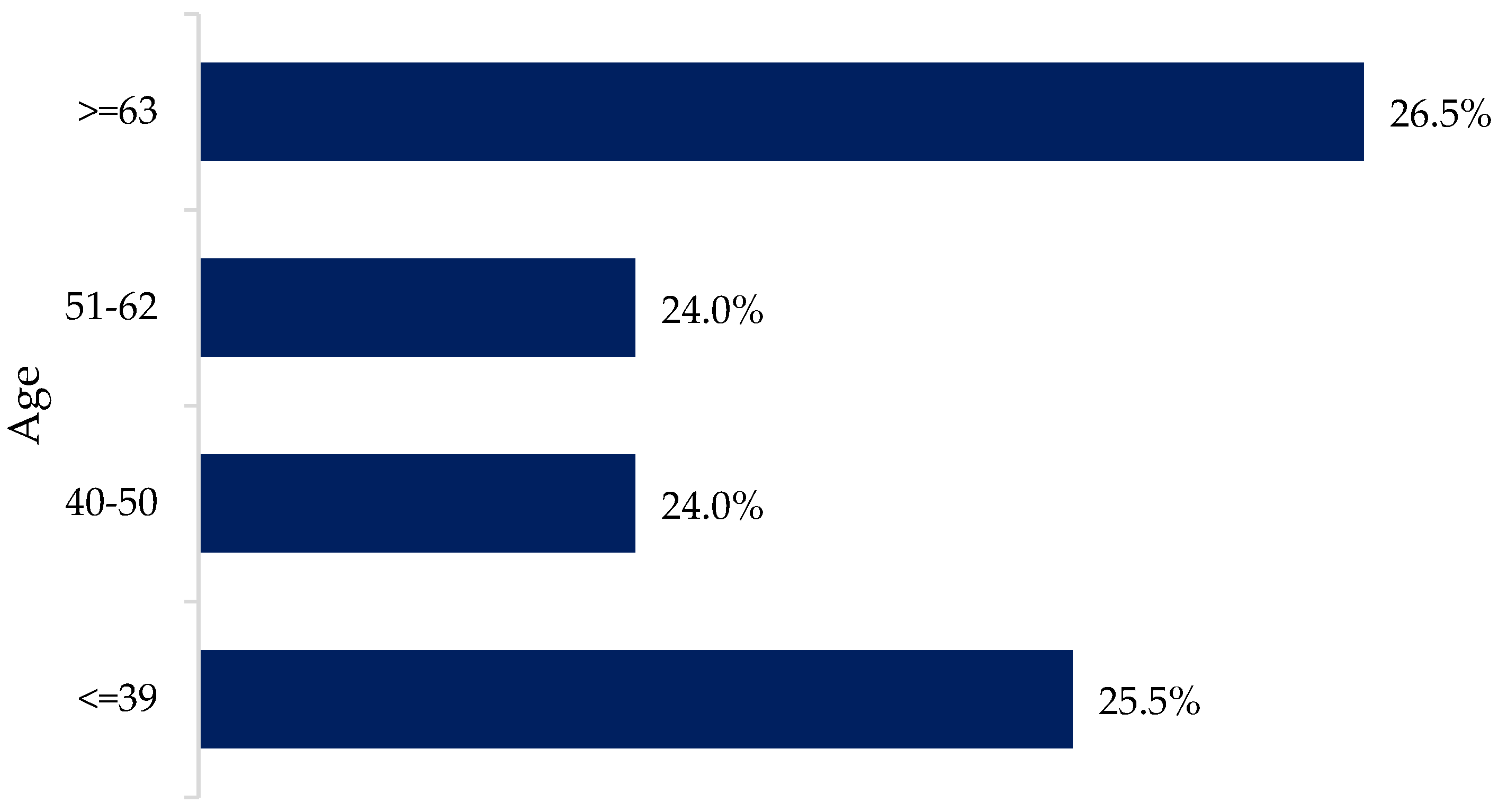
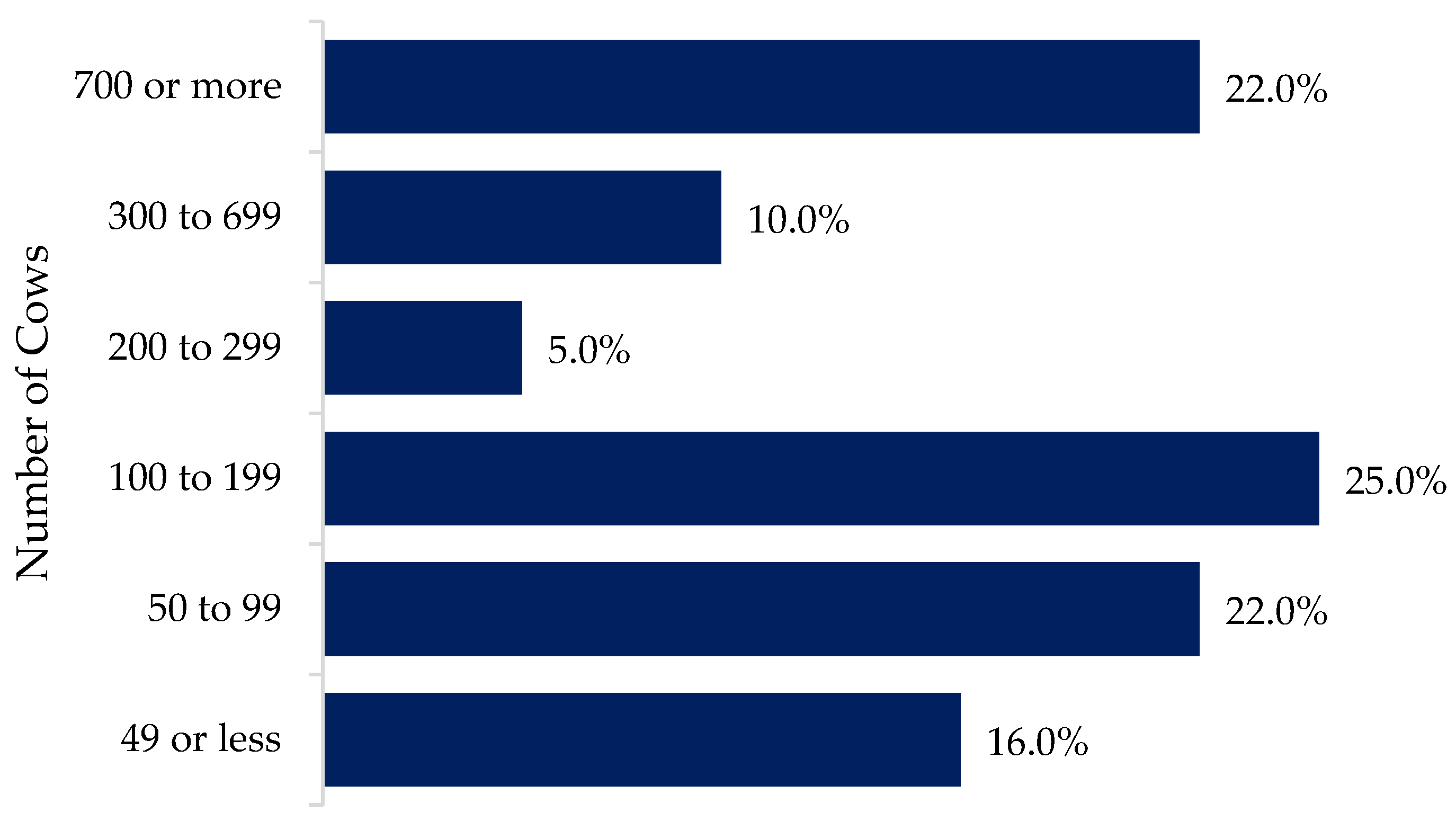
References
- Berckmans, D.; Guarino, M. From the Editors: Precision Livestock Farming for the Global Livestock Sector. Anim. Front. 2017, 7, 4–5. [Google Scholar] [CrossRef] [Green Version]
- Cabrera, V.E.; Barrientos-Blanco, J.A.; Delgado, H.; Fadul-Pacheco, L. Symposium Review: Real-Time Continuous Decision Making Using Big Data on Dairy Farms. J. Dairy Sci. 2020, 103, 3856–3866. [Google Scholar] [CrossRef]
- Eastwood, C.R.; Dela Rue, B.T.; Gray, D.I. Using a ‘Network of Practice’ Approach to Match Grazing Decision-Support System Design with Farmer Practice. Anim. Prod. Sci. 2017, 57, 1536. [Google Scholar] [CrossRef]
- Wolfert, S.; Ge, L.; Verdouw, C.; Bogaardt, M.-J. Big Data in Smart Farming—A Review. Agric. Syst. 2017, 153, 69–80. [Google Scholar] [CrossRef]
- Jouanjean, M.-A.; Casalini, F.; Wiseman, L.; Gray, E. Issues around Data Governance in the Digital Transformation of Agriculture: The Farmers’ Perspective; OECD Food, Agriculture and Fisheries Papers, No. 146; OECD Publishing: Paris, France, 2020. [Google Scholar] [CrossRef]
- Igor, I. How to Approach Data Ownership in AgTech? Gamaya Blog 2018. Available online: https://medium.com/remote-sensing-in-agriculture/how-to-approach-data-ownership-in-agtech-486179dc9377 (accessed on 2 November 2021).
- Jakku, E.; Taylor, B.; Fleming, A.; Mason, C.; Fielke, S.; Sounness, C.; Thorburn, P. “If They Don’t Tell Us What They Do with It, Why Would We Trust Them?” Trust, Transparency and Benefit-Sharing in Smart Farming. NJAS-Wagening. J. Life Sci. 2019, 90–91, 100285. [Google Scholar] [CrossRef]
- Wiseman, L.; Sanderson, J.; Robb, L. Rethinking Ag Data Ownership. Farm. Policy J. 2018, 15, 71–77. [Google Scholar]
- Wiseman, L.; Sanderson, J.; Zhang, A.; Jakku, E. Farmers and Their Data: An Examination of Farmers’ Reluctance to Share Their Data through the Lens of the Laws Impacting Smart Farming. NJAS-Wagening. J. Life Sci. 2019, 90–91, 100301. [Google Scholar] [CrossRef]
- van Schalkwyk, F.; Andrason, A.; Magalhaes, G. A New Harvest: A Review of the Literature on Data Ownership Focusing on the Agricultural Sector; Social Science Research Network: Rochester, NY, USA, 2018. [Google Scholar]
- Wysel, M.; Baker, D.; Billingsley, W. Data Sharing Platforms: How Value Is Created from Agricultural Data. Agric. Syst. 2021, 193, 103241. [Google Scholar] [CrossRef]
- Sanderson, J.; Wiseman, L.; Poncini, S. What’s behind the Ag-Data Logo? An Examination of Voluntary Agricultural-Data Codes of Practice. Int. J. Rural Law Policy 2018, 1, 1–21. [Google Scholar] [CrossRef]
- van der Burg, S.; Bogaardt, M.-J.; Wolfert, S. Ethics of Smart Farming: Current Questions and Directions for Responsible Innovation towards the Future. NJAS-Wagening. J. Life Sci. 2019, 90–91, 100289. [Google Scholar] [CrossRef]
- Dairy Brain Help Us Help You Make Better Use of Dairy Data. Available online: https://hoards.com/article-27981-help-us-help-you-make-better-use-of-dairy-data.html (accessed on 25 September 2020).
- GDPR General Data Protection Regulation (GDPR)—Official Legal Text. Available online: https://gdpr-info.eu/ (accessed on 14 May 2021).
- Qualtrics Software, Version August 31-2021. Copyright© 2020. Qualtrics and All Other Qualtrics Product or Service Names Are Registered Trademarks or Trademarks of Qualtrics, Provo, UT, USA. Available online: https://www.qualtrics.com (accessed on 15 January 2022).
- Census of Agriculture United States Summary and State Data. 2019. Available online: https://www.nass.usda.gov/Publications/AgCensus/2017/Full_Report/Volume_1,_Chapter_1_US/usv1.pdf (accessed on 13 October 2020).
- Qualtrics Statistical Test Assumptions & Technical Details. Available online: https://www.qualtrics.com/support/stats-iq/analyses/statistical-test-assumptions-technical-details/ (accessed on 14 October 2020).
- Batterton, K.A.; Hale, K.N. The Likert Scale What It Is and How To Use It. Phalanx 2017, 50, 32–39. [Google Scholar]
- International Committee for Animal Recording (ICAR). The Global Standard for Livestock Data. Available online: https://www.icar.org (accessed on 26 August 2021).
- American Association of Bovine Practitioners. Available online: https://www.aabp.org (accessed on 13 October 2021).
- National Mastitis Council. Available online: https://www.nmconline.org (accessed on 13 October 2021).
- S.2487—Agriculture Data Act of 2018. Available online: https://www.congress.gov/bill/115th-congress/senate-bill/2487/text?q=%7B%22search%22%3A%5B%22Agriculture+Data+Act%22%5D%7D&r=1 (accessed on 13 October 2021).
- Giesbers, E.; Adema, H.; Soum, C.; Van Der Burg, S. Toward Broader Sharing of Farm Data. 2021. Available online: https://www.iof2020.eu/education-material-webinars/iof2020-final-report-data-sharing.pdf (accessed on 1 November 2021).
- Obar, J.A.; Oeldorf-Hirsch, A. The Biggest Lie on the Internet: Ignoring the Privacy Policies and Terms of Service Policies of Social Networking Services. Inf. Commun. Soc. 2020, 23, 128–147. [Google Scholar] [CrossRef]
- LePan, N. Visualizing the Length of the Fine Print, for 14 Popular Apps. Available online: https://www.visualcapitalist.com/terms-of-service-visualizing-the-length-of-internet-agreements/ (accessed on 26 June 2021).
- Zhang, A.; Heath, R.; McRobert, K.; Llewellyn, R.; Sanderson, J.; Wiseman, L.; Rainbow, R. Who Will Benefit from Big Data? Farmers’ Perspective on Willingness to Share Farm Data. J. Rural Stud. 2021, 88, 346–353. [Google Scholar] [CrossRef]
- Langley, P.; Leyshon, A. Platform Capitalism: The Intermediation and Capitalization of Digital Economic Circulation. Financ. Soc. 2017, 3, 11–31. [Google Scholar] [CrossRef] [Green Version]
- Foy, D. Farmers Own Their Data! 2021. Available online: https://agrigates.io/farmers-own-their-data/ (accessed on 8 November 2021).
- Cabrera, V.E.; Fadul-Pacheco, L. Future of Dairy Farming from the Dairy Brain Perspective: Data Integration, Analytics, and Applications. Int. Dairy J. 2021, 121, 105069. [Google Scholar] [CrossRef]
- Cockburn, M. Review: Application and Prospective Discussion of Machine Learning for the Management of Dairy Farms. Animals 2020, 10, 1690. [Google Scholar] [CrossRef]
- Gillespie, J.; Nehring, R.; Sitienei, I. The Adoption of Technologies, Management Practices, and Production Systems in U.S. Milk Production. Agric. Food Econ. 2014, 2, 17. [Google Scholar] [CrossRef] [Green Version]
- Khanal, A.R.; Gillespie, J.; MacDonald, J. Adoption of Technology, Management Practices, and Production Systems in US Milk Production. J. Dairy Sci. 2010, 93, 6012–6022. [Google Scholar] [CrossRef] [PubMed]
- Michels, M.; von Hobe, C.-F.; Musshoff, O. A Trans-Theoretical Model for the Adoption of Drones by Large-Scale German Farmers. J. Rural Stud. 2020, 75, 80–88. [Google Scholar] [CrossRef]
- Tamirat, T.W.; Pedersen, S.M.; Lind, K.M. Farm and Operator Characteristics Affecting Adoption of Precision Agriculture in Denmark and Germany. Acta Agric. Scand. Sect. B—Soil Plant Sci. 2018, 68, 349–357. [Google Scholar] [CrossRef]
- Brown, P.; Daigneault, A.; Dawson, J. Age, Values, Farming Objectives, Past Management Decisions, and Future Intentions in New Zealand Agriculture. J. Environ. Manag. 2019, 231, 110–120. [Google Scholar] [CrossRef] [PubMed]
- Abdulkadri, A.O. Estimating Risk Aversion Coefficients for Dry Land Wheat, Irrigated Corn and Dairy Producers in Kansas. Appl. Econ. 2003, 35, 825–834. [Google Scholar] [CrossRef]
- Pierpaoli, E.; Carli, G.; Pignatti, E.; Canavari, M. Drivers of Precision Agriculture Technologies Adoption: A Literature Review. Procedia Technol. 2013, 8, 61–69. [Google Scholar] [CrossRef] [Green Version]
- Burton, R.J.F. An Alternative to Farmer Age as an Indicator of Life-Cycle Stage: The Case for a Farm Family AgeIndex. J. Rural Stud. 2006, 22, 485–492. [Google Scholar] [CrossRef]
- Baldin, M.; Breunig, T.; Cue, R.; De Vries, A.; Doornink, M.; Drevenak, J.; Fourdraine, R.; George, R.; Goodling, R.; Greenfield, R.; et al. Integrated Decision Support Systems (IDSS) for Dairy Farming: A Discussion on How to Improve Their Sustained Adoption. Animals 2021, 11, 2025. [Google Scholar] [CrossRef] [PubMed]


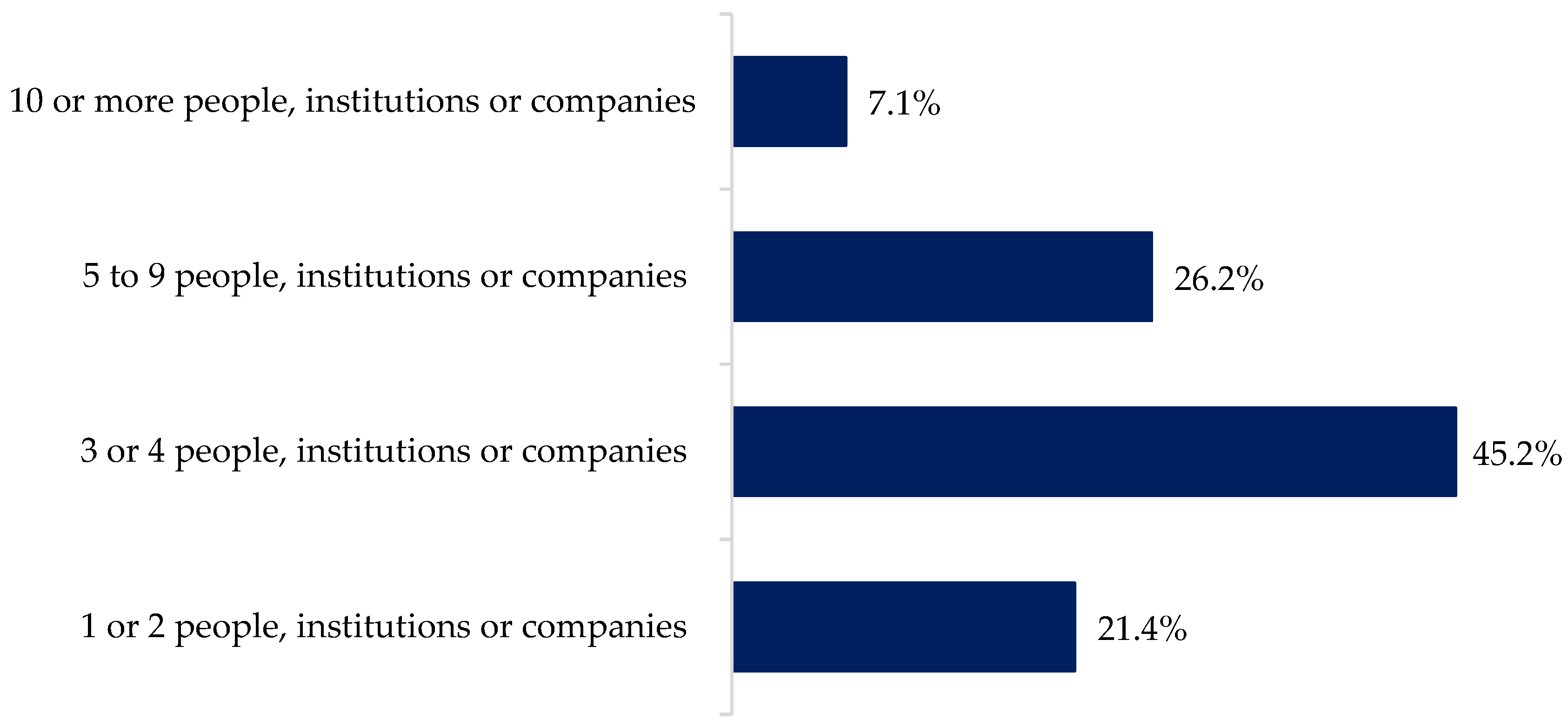
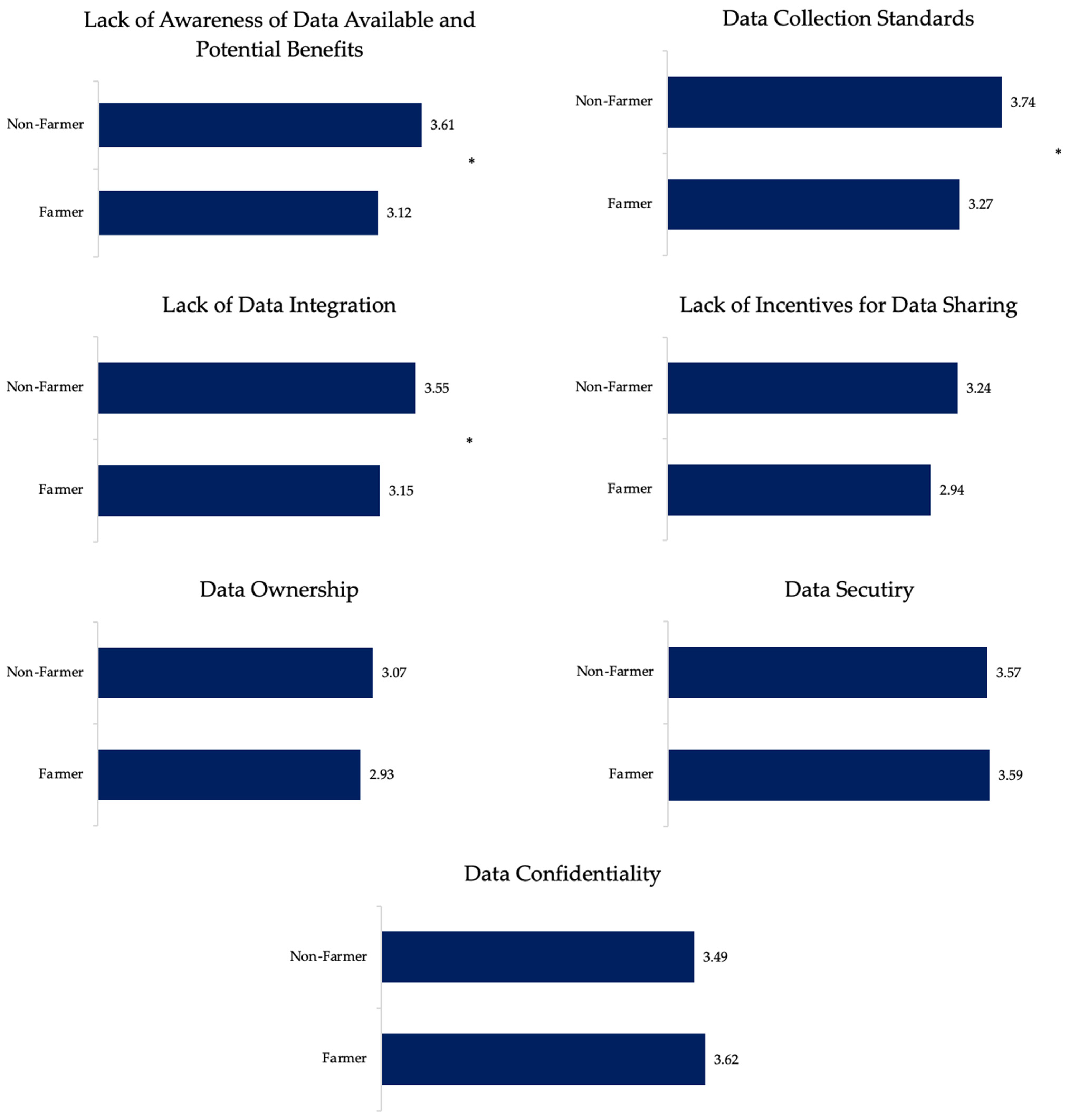
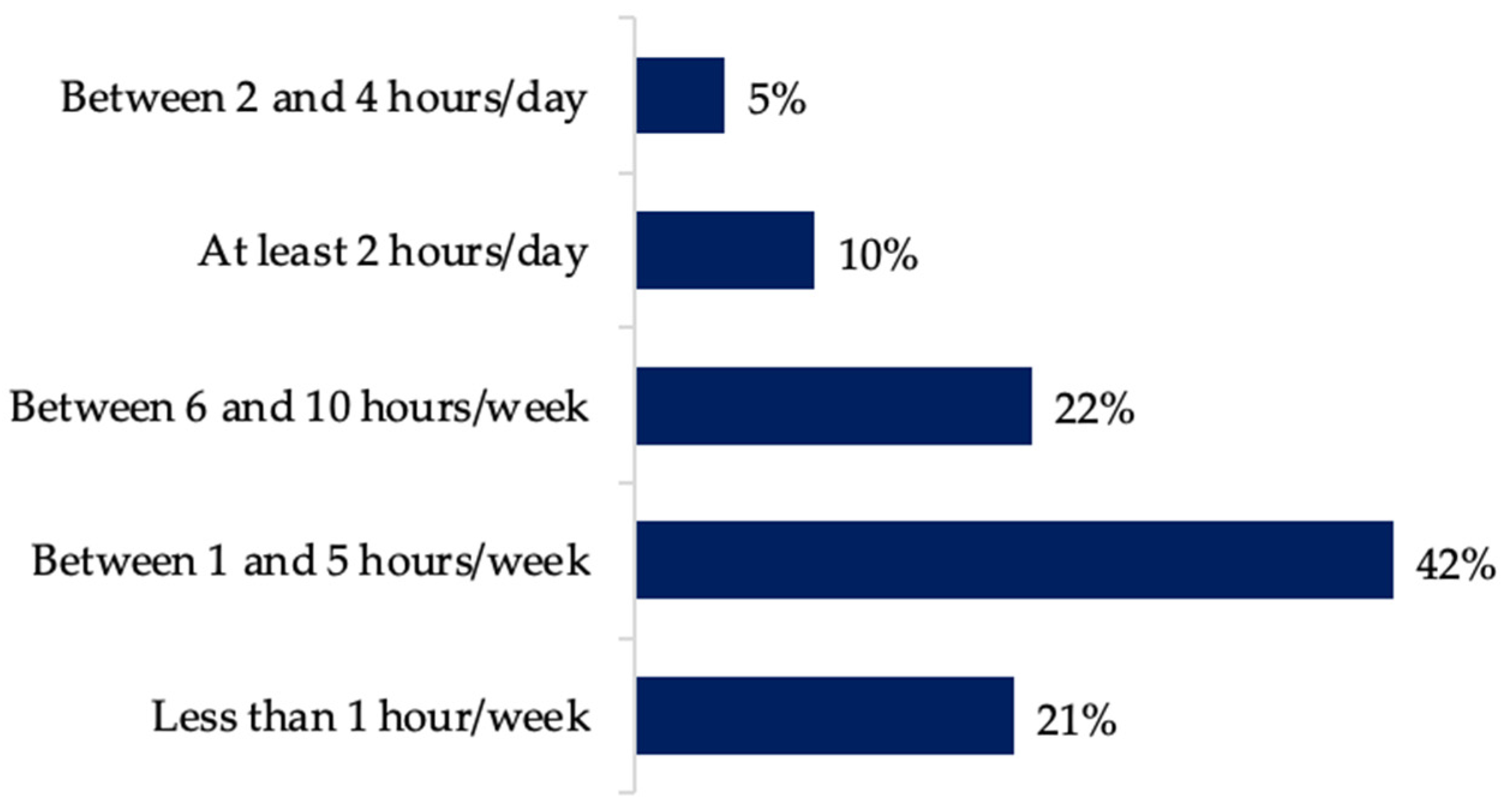
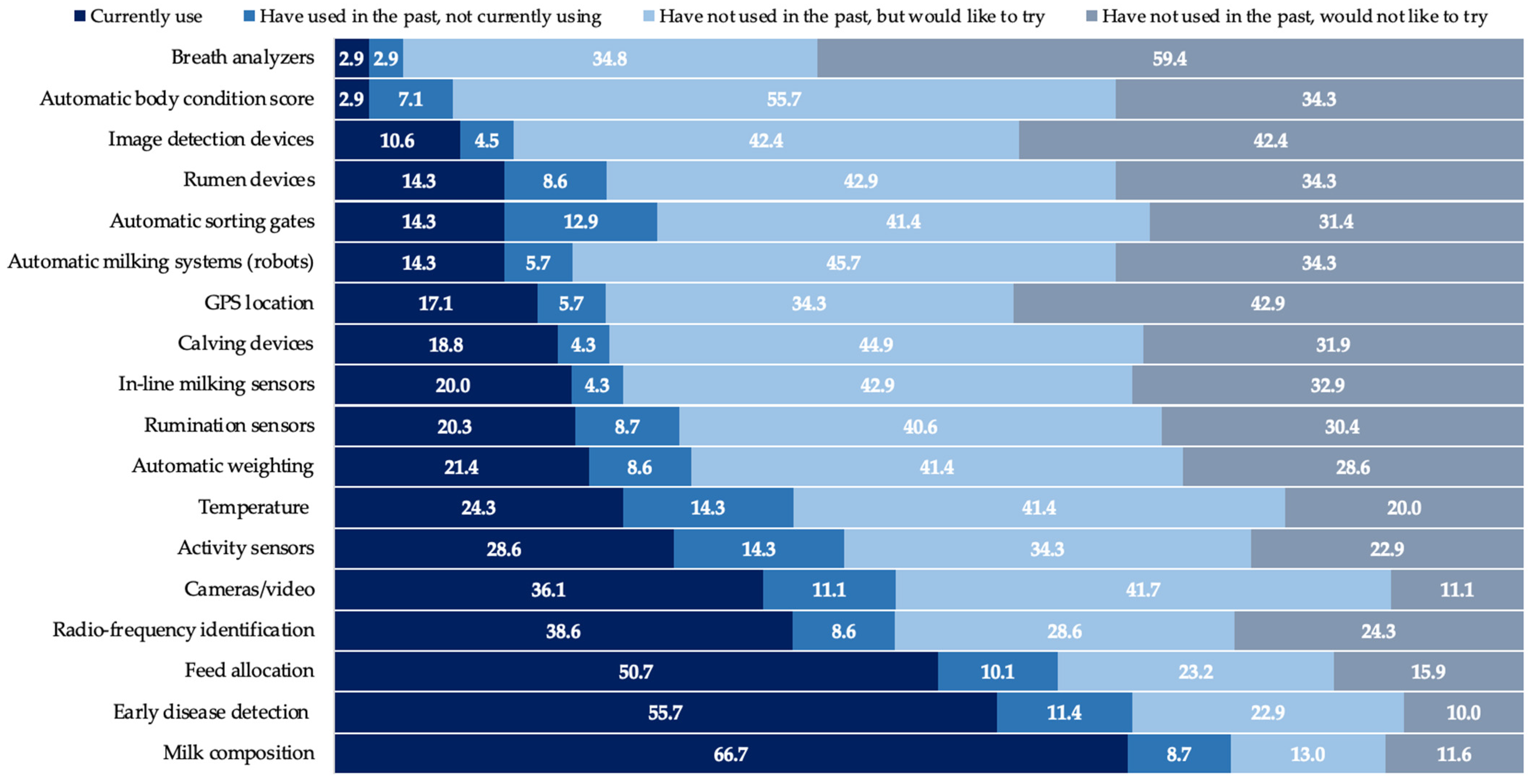
| Question | Farmer Agreeing with Statement, % | Non-Farmer Agreeing with Statement, % | p-Value |
|---|---|---|---|
| Knowledge about data collection protocols a | 27 | 35 | NA b |
| Data sharing out of the farm is worth it | 84.5 | 95.8 | 0.14 |
| Farmer signed a data share agreement in the last five years | 19.2 | NA c | NA b |
| Farmer knows who has access to their farm data | 34.3 | NA c | NA b |
| Never or rarely read the terms and conditions before clicking “I agree” | 68.5 | 66.7 | 0.38 |
| Farmer sole owner of raw data collected at the farm | 48 | 55 | 0.32 |
| Companies or researchers should pay the farmer for sharing raw data | 68.3 | 31.7 | 0.03 |
| Intellectual property of a product developed by a university, research institution or company should be shared with the farmer, researcher, university, research institution, or company | 57.5 | 45.8 | 0.06 |
| Data quality should determine the amount of payment when compensating for data | 90.3 | NA b | |
| Question | Farmer Agreeing with Statement, % | Non-Farmer Agreeing with Statement, % | p-Value |
|---|---|---|---|
| Use of transformed data for decision making | 62 | 82 | 0.009 |
| Currently paying to access transformed data of their farms | 27 | NA a | NA a |
| Price paid to access their transformed data is fair | 66.7 | NA a | NA a |
| Charged price to access the transformed data is fair | NA a | 82.4 | NA a |
| Time exploring data for decision making is less than 1 h/day | 63 | NA a | NA a |
| Using integrated data is useful | 68 | 70 | 0.320 |
| Data integration is done manually | 47 | 34 | 0.295 |
| Keep historical data is a common practice | 87 | NA a | NA a |
| Question | Farmer Agreeing with Statement, % |
|---|---|
| Automatic body condition score technologies had the most interest to be adopted | 56 |
| Abandonment across technologies was relatively low | 10.4 |
| Ease of implementation is a must for the adoption of a technology | 69 |
| Daily reports are the preferred reporting mechanism | 44 |
| ‘When to cull a cow’ is the most common decision taken from a decision support tool | 83 |
Publisher’s Note: MDPI stays neutral with regard to jurisdictional claims in published maps and institutional affiliations. |
© 2022 by the authors. Licensee MDPI, Basel, Switzerland. This article is an open access article distributed under the terms and conditions of the Creative Commons Attribution (CC BY) license (https://creativecommons.org/licenses/by/4.0/).
Share and Cite
Fadul-Pacheco, L.; Wangen, S.R.; da Silva, T.E.; Cabrera, V.E. Addressing Data Bottlenecks in the Dairy Farm Industry. Animals 2022, 12, 721. https://doi.org/10.3390/ani12060721
Fadul-Pacheco L, Wangen SR, da Silva TE, Cabrera VE. Addressing Data Bottlenecks in the Dairy Farm Industry. Animals. 2022; 12(6):721. https://doi.org/10.3390/ani12060721
Chicago/Turabian StyleFadul-Pacheco, Liliana, Steven R. Wangen, Tadeu Eder da Silva, and Victor E. Cabrera. 2022. "Addressing Data Bottlenecks in the Dairy Farm Industry" Animals 12, no. 6: 721. https://doi.org/10.3390/ani12060721






